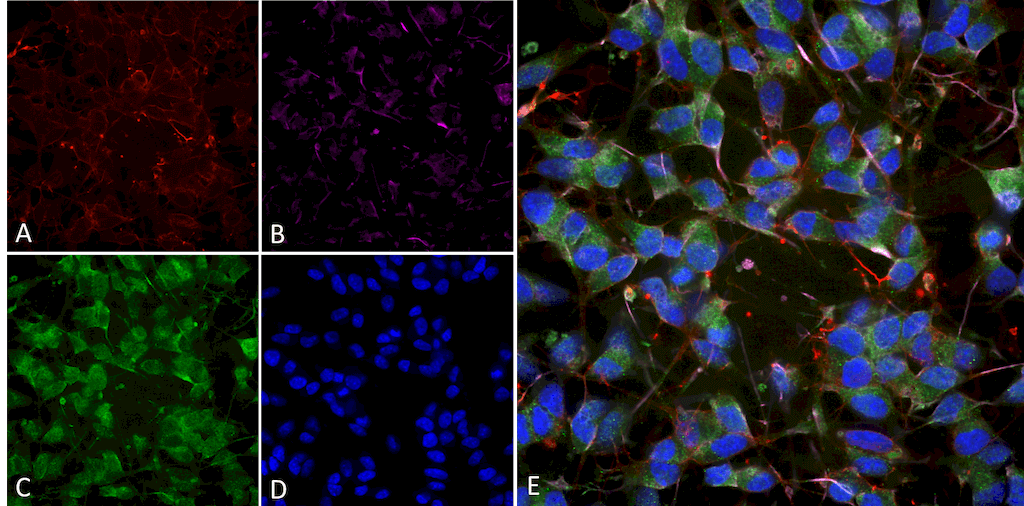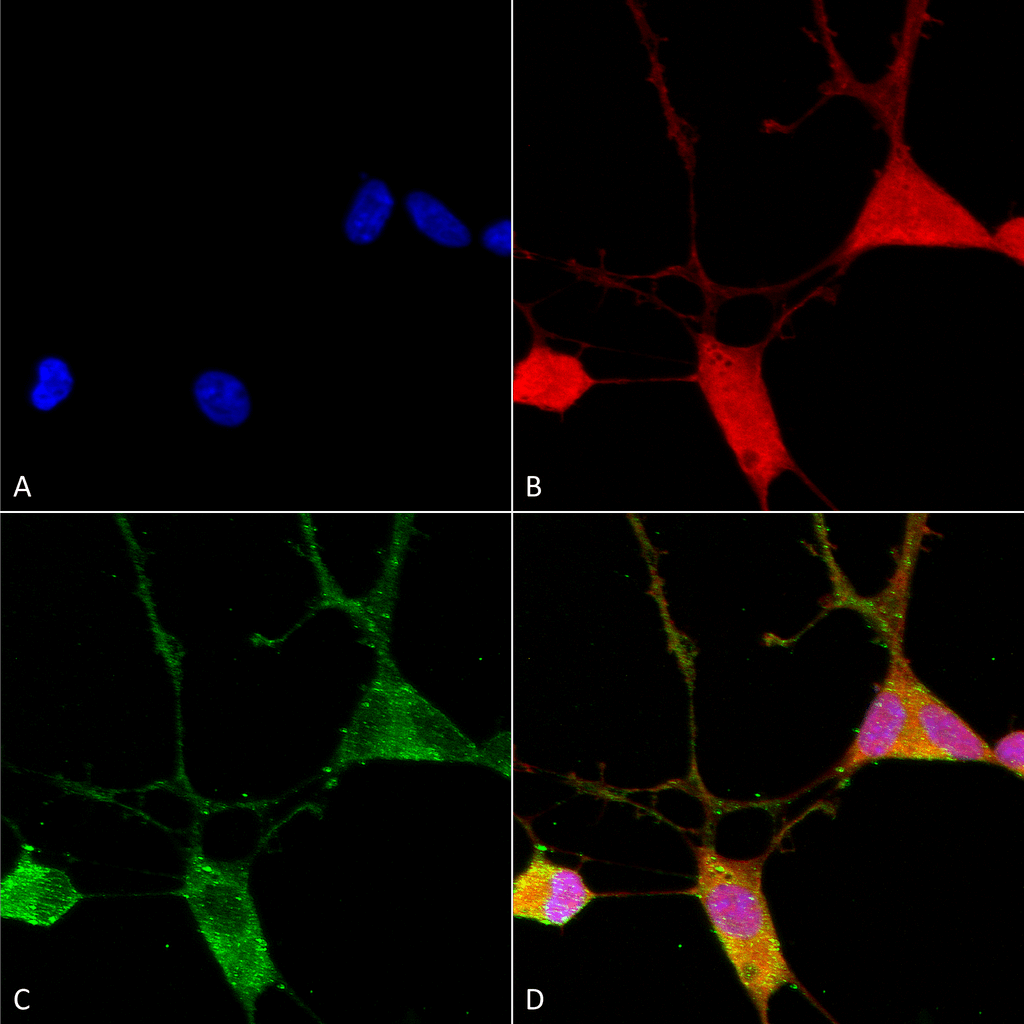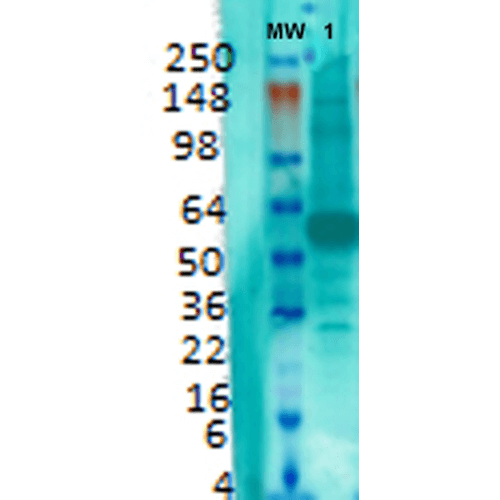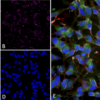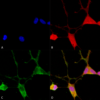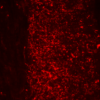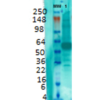Anti-VGlut1 Transporter Antibody (56514)
$466.00
SKU: 56514
Categories: Antibody Products, Neuroscience and Signal Transduction Antibodies, New Products, Products
Overview
Product Name Anti-VGlut1 Transporter Antibody (56514)
Description Anti-VGlut1 Transporter Mouse Monoclonal Antibody
Target VGlut1 Transporter
Species Reactivity Human, Mouse, Rat
Applications WB,IHC
Host Mouse
Clonality Monoclonal
Clone ID S28-9
Isotype IgG1
Immunogen Fusion protein corresponding to aa 493-560 (cytoplasmic C-terminus) of rat VGlut1 (accession no. NP_446311).
Properties
Form Liquid
Concentration 1.0 mg/mL
Formulation PBS, pH 7.4, 50% glycerol, 0.09% sodium azide.Purified by Protein G affinity chromatography.
Buffer Formulation Phosphate Buffered Saline
Buffer pH pH 7.4
Buffer Anti-Microbial 0.09% Sodium Azide
Buffer Cryopreservative 50% Glycerol
Format Purified
Purification Purified by Protein G affinity chromatography
Specificity Information
Specificity This antibody recognizes human, mouse, and rat VGlut1. It does not cross-react with VGlut2.
Target Name Vesicular glutamate transporter 1
Target ID VGlut1 Transporter
Uniprot ID Q62634
Alternative Names VGluT1, Brain-specific Na(+-dependent inorganic phosphate cotransporter, Solute carrier family 17 member 7
Gene Name Slc17a7
Sequence Location Cytoplasmic vesicle, secretory vesicle, synaptic vesicle membrane, Membrane, Cell junction, synapse, synaptosome
Biological Function Mediates the uptake of glutamate into synaptic vesicles at presynaptic nerve terminals of excitatory neural cells. May also mediate the transport of inorganic phosphate. {PubMed:10938000, PubMed:11001057, PubMed:11698619, PubMed:11698620, PubMed:18080752, PubMed:8202535}.
Research Areas Neuroscience
Background VGlut1 is expressed in a subset of glutamate neurons where it transports glutamate into native synaptic vesicles from the brain. Glutamate transport by VGlut1 is saturated with a K(m) of approximately 2mM. Whereas plasma membrane glutamate transporters recognize both aspartate and glutamate as substrates, VGlut1 recognizes only glutamate.
Application Images





Description Immunocytochemistry/Immunofluorescence analysis using Mouse Anti-VGLUT1 Monoclonal Antibody, Clone S28-9 (56514). Tissue: Differentiated SH-SY5Y. Species: Human. Primary Antibody: Mouse Anti-VGLUT1 Monoclonal Antibody (56514) at 1:100. Secondary Antibody: AlexaFluor 488. Counterstain: phalloidin (Alexa 647, red), beta tubulin (Anti-beta III Tubulin Ab, Alexa 555, magenta) Hoechst (blue). (A) Phalloidin (B) Anti-beta III Tubulin Ab. (C) VGLUT1 Antibody. (D) Hoechst (E) Composite.

Description Immunocytochemistry/Immunofluorescence analysis using Mouse Anti-VGLUT1 Monoclonal Antibody, Clone S28-9 (56514). Tissue: Neuroblastoma cells (SH-SY5Y). Species: Human. Fixation: 4% PFA for 15 min. Primary Antibody: Mouse Anti-VGLUT1 Monoclonal Antibody (56514) at 1:100 for overnight at 4°C with slow rocking. Secondary Antibody: AlexaFluor 488 at 1:1000 for 1 hour at RT. Counterstain: Phalloidin-iFluor 647 (red) F-Actin stain; Hoechst (blue) nuclear stain at 1:800, 1.6mM for 20 min at RT. (A) Hoechst (blue) nuclear stain. (B) Phalloidin-iFluor 647 (red) F-Actin stain. (C) VGLUT1 Antibody (D) Composite.

Description Immunohistochemistry analysis using Mouse Anti-VGLUT1 Monoclonal Antibody, Clone S28-9 (56514). Tissue: spinal cord. Species: Mouse. Fixation: 4% PFA. Primary Antibody: Mouse Anti-VGLUT1 Monoclonal Antibody (56514) at 1:500 for 16 hours at RT. Secondary Antibody: Alexa Fluor 555 Donkey Anti-Mouse (red) at 1:2000 for 2 hours at RT. Counterstain: NeuN neuronal stain (green). Magnification: 20X. Courtesy of: Leilei Wang, Ph.D. UT Southwestern Medical Center at Dallas.

Description Western Blot analysis of Rat brain membrane lysate showing detection of VGLUT1 protein using Mouse Anti-VGLUT1 Monoclonal Antibody, Clone S28-9 (56514). Primary Antibody: Mouse Anti-VGLUT1 Monoclonal Antibody (56514) at 1:1000.
Handling
Storage This product is stable for at least 1 year at -20°C. Freeze in multiple aliquots to avoid repeated freeze-thaw cycles.
Dilution Instructions Dilute in PBS or medium that is identical to that used in the assay system.
Application Instructions Immunoblotting: use at 1-2ug/mL. A band of ~52kDa is detected.
Immunohistochemistry: use at 1-5ug/mL.
These are recommended concentrations.
Enduser should determine optimal concentrations for their applications.
Positive control: rat brain lysate.
Immunohistochemistry: use at 1-5ug/mL.
These are recommended concentrations.
Enduser should determine optimal concentrations for their applications.
Positive control: rat brain lysate.
References & Data Sheet
Data Sheet  Download PDF Data Sheet
Download PDF Data Sheet
 Download PDF Data Sheet
Download PDF Data Sheet

